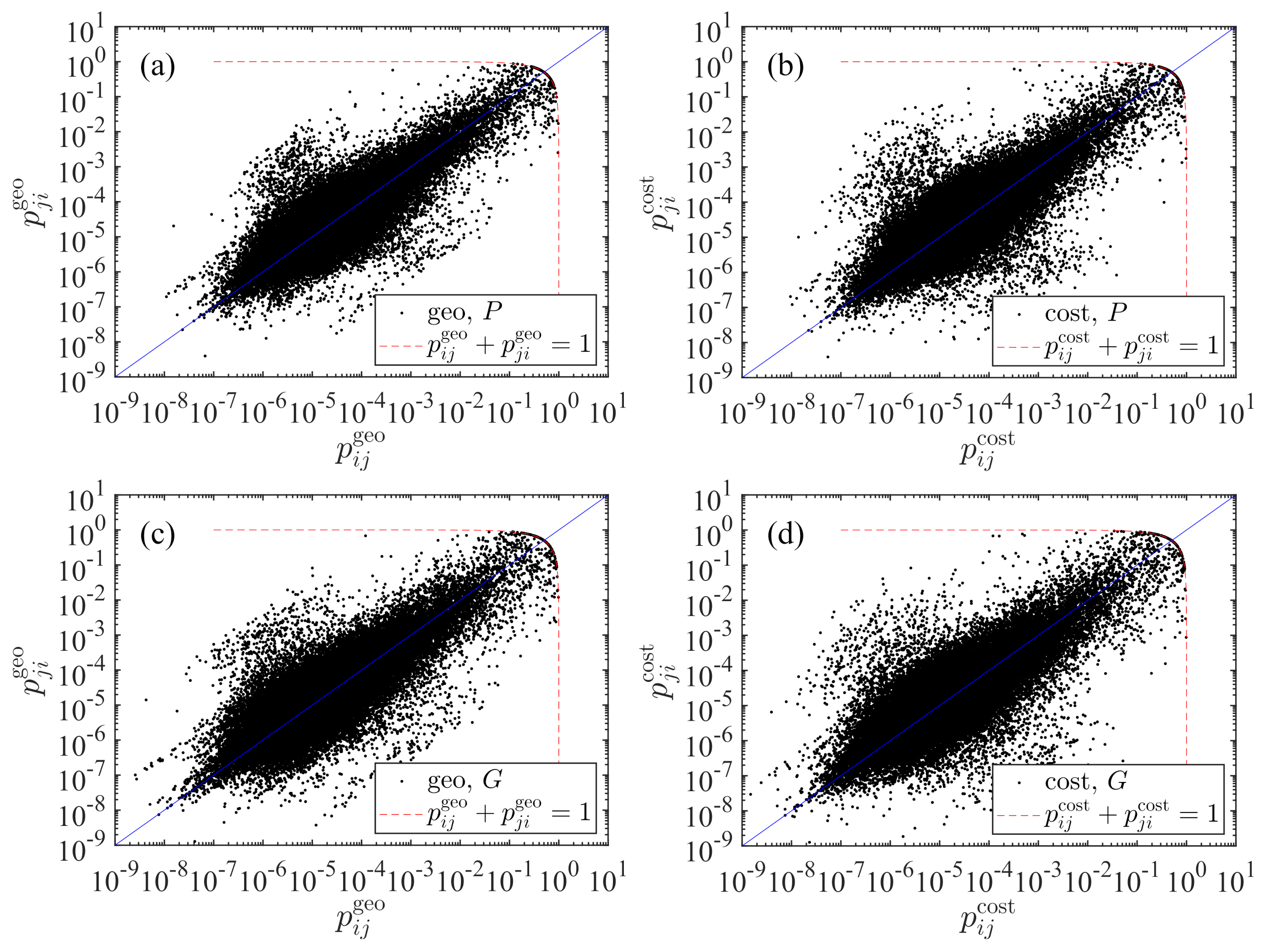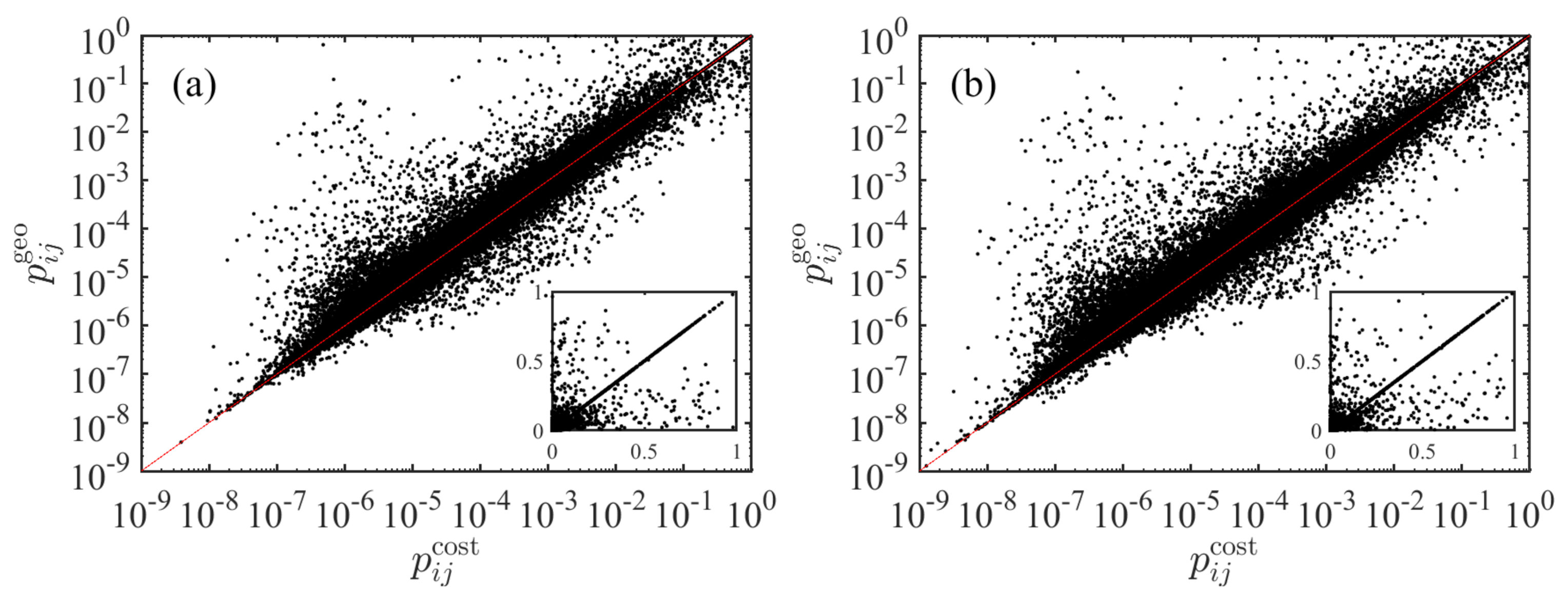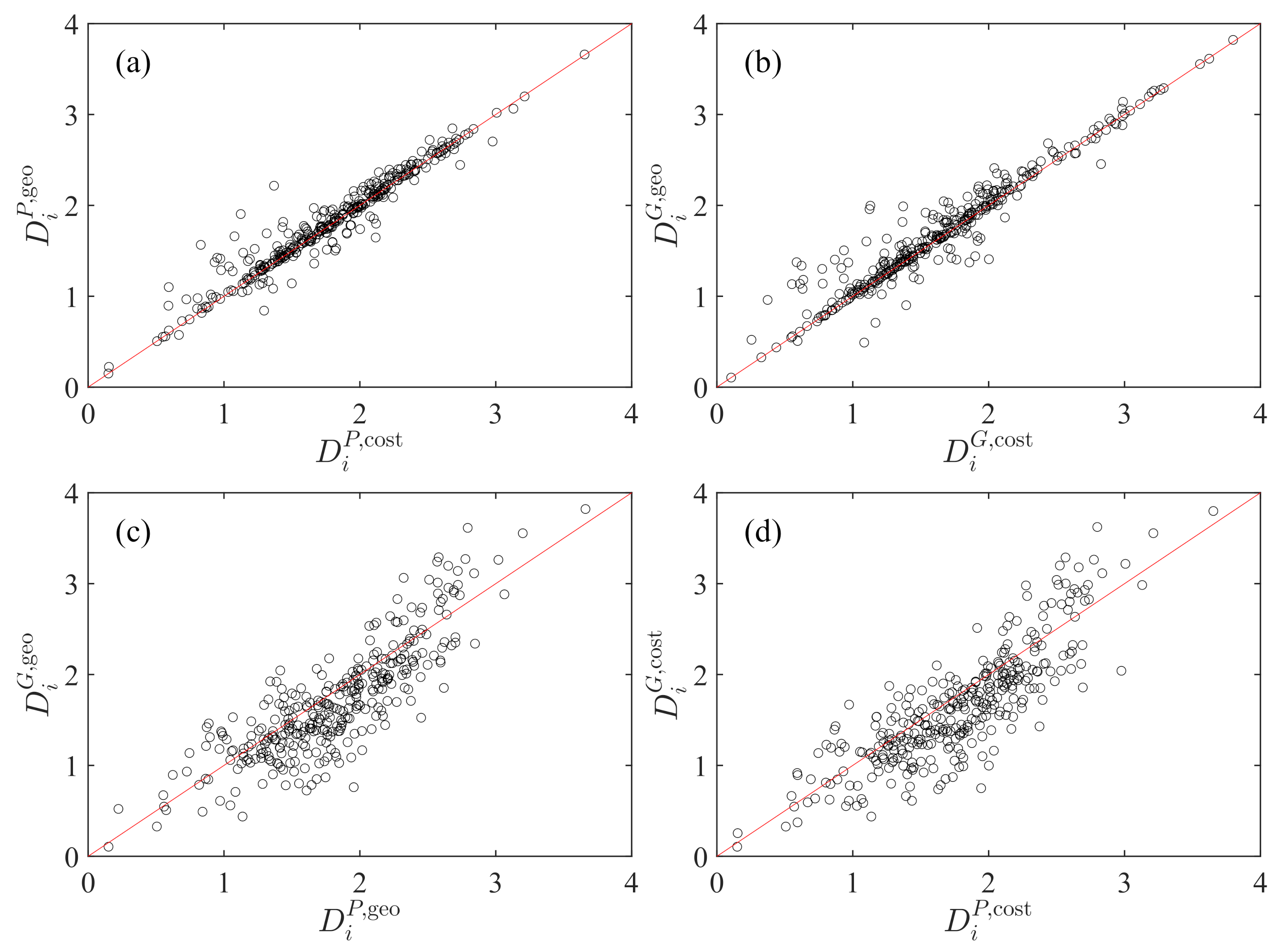Highway Freight Transportation Diversity of Cities Based on Radiation Models
Abstract
:1. Introduction
2. Data Sets
3. Transportation Probability
3.1. Formulae
3.2. Power-Law Distribution of
3.3. Asymmetric Relationship between and
3.4. Comparison between and
4. Transportation Diversity
4.1. Comparison of Diversity Based on Population and Gross Domestic Product
4.2. Dependence of City Traits on Diversity
5. Discussion and Conclusions
Author Contributions
Funding
Institutional Review Board Statement
Informed Consent Statement
Data Availability Statement
Conflicts of Interest
References
- Belokurov, V.; Spodarev, R.; Belokurov, S. Determining passenger traffic as important factor in urban public transport system. Transp. Res. Proc. 2020, 50, 52–58. [Google Scholar] [CrossRef]
- Albayrak, M.B.K.; Ozcan, I.C.; Can, R.; Dobruszkes, F. The determinants of air passenger traffic at Turkish airports. J. Air Transp. Manag. 2020, 86, 101818. [Google Scholar] [CrossRef]
- Pasha, J.; Dulebenets, M.A.; Kavoosi, M.; Abioye, O.F.; Theophilus, O.; Wang, H.; Kampmann, R.; Guo, W. Holistic tactical-level planning in liner shipping: An exact optimization approach. J. Ship. Trade 2020, 5, 8. [Google Scholar] [CrossRef]
- Enoch, M.P.; Cross, R.; Potter, N.; Davidson, C.; Taylor, S.; Brown, R.; Huang, H.; Parsons, J.; Tucker, S.; Wynne, E.; et al. Future local passenger transport system scenarios and implications for policy and practice. Transp. Policy 2020, 90, 52–67. [Google Scholar] [CrossRef]
- Dulebenets, M.A. An adaptive island evolutionary algorithm for the berth scheduling problem. Memet. Comput. 2020, 12, 51–72. [Google Scholar] [CrossRef]
- Wang, L.; Ma, J.C.; Jiang, Z.Q.; Yan, W.; Zhou, W.X. Gravity law in the Chinese highway freight transportation networks. EPJ Data Sci. 2019, 8, 37. [Google Scholar] [CrossRef] [Green Version]
- Jung, W.S.; Wang, F.Z.; Stanley, H.E. Gravity model in the Korean highway. EPL (Europhys. Lett.) 2008, 81, 48005. [Google Scholar] [CrossRef] [Green Version]
- Masucci, A.P.; Serras, J.; Johansson, A.; Batty, M. Gravity versus radiation models: On the importance of scale and heterogeneity in commuting flows. Phys. Rev. E 2013, 88, 022812. [Google Scholar] [CrossRef] [Green Version]
- Lenormand, M.; Bassolas, A.; Ramasco, J.J. Systematic comparison of trip distribution laws and models. J. Transp. Geogr. 2016, 51, 158–169. [Google Scholar] [CrossRef] [Green Version]
- Barbosa, H.; Barthelemy, M.; Ghoshal, G.; James, C.R.; Lenormand, M.; Louail, T.; Menezes, R.; Ramasco, J.J.; Simini, F.; Tomasini, M. Human mobility: Models and applications. Phys. Rep. 2018, 734, 1–74. [Google Scholar] [CrossRef] [Green Version]
- Piovani, D.; Arcaute, E.; Uchoa, G.; Wilson, A.; Batty, M. Measuring accessibility using gravity and radiation models. R. Soc. Open Sci. 2018, 5, 171668. [Google Scholar] [CrossRef] [PubMed] [Green Version]
- Kwon, O.; Jung, W.S. Intercity express bus flow in Korea and its network analysis. Phys. A 2012, 391, 4261–4265. [Google Scholar] [CrossRef]
- Hong, I.; Jung, W.S. Application of gravity model on the Korean urban bus network. Phys. A 2016, 462, 48–55. [Google Scholar] [CrossRef]
- Simini, F.; González, M.C.; Maritan, A.; Barabási, A.L. A universal model for mobility and migration patterns. Nature 2012, 484, 96–100. [Google Scholar] [CrossRef] [PubMed]
- Ren, Y.; Ercsey-Ravasz, M.; Wang, P.; Gonzalez, M.C.; Toroczkai, Z. Predicting commuter flows in spatial networks using a radiation model based on temporal ranges. Nat. Commun. 2014, 5, 5347. [Google Scholar] [CrossRef] [PubMed] [Green Version]
- Yang, Y.; Herrera, C.; Eagle, N.; Gonzalez, M.C. Limits of predictability in commuting flows in the absence of data for calibration. Sci. Rep. 2014, 4, 5662. [Google Scholar] [CrossRef] [Green Version]
- Yan, X.Y.; Wang, W.X.; Gao, Z.Y.; Lai, Y.C. Universal model of individual and population mobility on diverse spatial scales. Nat. Commun. 2017, 8, 1639. [Google Scholar] [CrossRef] [Green Version]
- Lenormand, M.; Huet, S.; Gargiulo, F.; Deffuant, G. A universal model of commuting networks. PLoS ONE 2012, 7, e45985. [Google Scholar] [CrossRef]
- Gargiulo, F.; Lenormand, M.; Huet, S.; Espinosa, O.B. Commuting network models: Getting the essentials. J. Artif. Soc. Soc. Simul. 2012, 15, 6. [Google Scholar] [CrossRef]
- Lenormand, M.; Huet, S.; Gargiulo, F. Generating French virtual commuting networks at the municipality level. J. Transp. Land Use 2014, 7, 43–55. [Google Scholar] [CrossRef] [Green Version]
- Xia, N.; Cheng, L.; Chen, S.; Wei, X.; Zong, W.; Li, M. Accessibility based on gravity-radiation model and Google Maps API: A case study in Australia. J. Transp. Geogr. 2018, 72, 178–190. [Google Scholar] [CrossRef]
- Serrano, M.A.; Boguñá, M. Topology of the world trade web. Phys. Rev. E 2003, 68, 015101. [Google Scholar] [CrossRef] [PubMed] [Green Version]
- Garlaschelli, D.; Loffredo, M. Patterns of link reciprocity in directed networks. Phys. Rev. Lett. 2004, 93, 268701. [Google Scholar] [CrossRef] [Green Version]
- Zhou, W.X.; Wang, L.; Xie, W.J.; Yan, W. Predicting highway freight transportation networks using radiation models. Phys. Rev. E 2020, 102, 052314. [Google Scholar] [CrossRef]
- Eagle, N.; Macy, M.; Claxton, R. Network diversity and economic development. Science 2010, 328, 1029–1031. [Google Scholar] [CrossRef]
- Yan, X.Y.; Han, X.P.; Wang, B.H.; Zhou, T. Diversity of individual mobility patterns and emergence of aggregated scaling laws. Sci. Rep. 2013, 3, 2678. [Google Scholar] [CrossRef] [PubMed]
- Liu, E.J.; Yan, X.Y. A universal opportunity model for human mobility. Sci. Rep. 2020, 10, 4657. [Google Scholar] [CrossRef] [PubMed]
- Bettencourt, L.M.A.; Lobo, J.; Helbing, D.; Kuhnert, C.; West, G.B. Growth, innovation, scaling, and the pace of life in cities. Proc. Natl. Acad. Sci. USA 2007, 104, 7301–7306. [Google Scholar] [CrossRef] [PubMed] [Green Version]





| Model | ||||
|---|---|---|---|---|
| 1.8111 | 1.8063 | 2.1558 | 1.9829 | |
| 1.8863 | 1.8890 | 2.2277 | 2.1775 | |
| 1.2384 | 1.6523 | 1.7299 | 1.5613 | |
| 1.2838 | 1.7246 | 1.8990 | 1.6471 |
Publisher’s Note: MDPI stays neutral with regard to jurisdictional claims in published maps and institutional affiliations. |
© 2021 by the authors. Licensee MDPI, Basel, Switzerland. This article is an open access article distributed under the terms and conditions of the Creative Commons Attribution (CC BY) license (https://creativecommons.org/licenses/by/4.0/).
Share and Cite
Wang, L.; Ma, J.-C.; Jiang, Z.-Q.; Yan, W.; Zhou, W.-X. Highway Freight Transportation Diversity of Cities Based on Radiation Models. Entropy 2021, 23, 637. https://0-doi-org.brum.beds.ac.uk/10.3390/e23050637
Wang L, Ma J-C, Jiang Z-Q, Yan W, Zhou W-X. Highway Freight Transportation Diversity of Cities Based on Radiation Models. Entropy. 2021; 23(5):637. https://0-doi-org.brum.beds.ac.uk/10.3390/e23050637
Chicago/Turabian StyleWang, Li, Jun-Chao Ma, Zhi-Qiang Jiang, Wanfeng Yan, and Wei-Xing Zhou. 2021. "Highway Freight Transportation Diversity of Cities Based on Radiation Models" Entropy 23, no. 5: 637. https://0-doi-org.brum.beds.ac.uk/10.3390/e23050637






